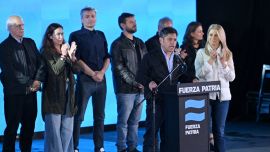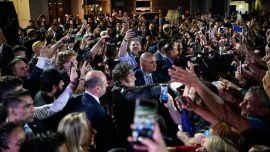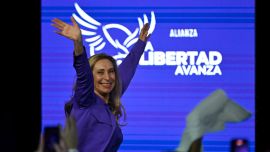Even if this country is so ultra-centralised in this city and even if the pundits are forever dubbing Buenos Aires Province “the mother of all battles,” electoral contests tend not to begin around here, which is just as well for the health of federalism – back in 2023, the general elections kicked off in Patagonia with the La Pampa PASO primaries (February 12) and the Neuquén provincial elections (April 16), while this year’s midterm voting begins tomorrow in the major province of Santa Fe with the constituent assembly elections (along with some local governments).
These elections are interesting not only because they are the first but because they potentially clash with the government’s core electoral strategy, seeking to polarise the electorate against Kirchnerism while squeezing out the middle ground – not only do tomorrow’s Santa Fe constituent assembly elections offer a third way but that third way is very likely to triumph under the leadership of popular Radical Governor Maximiliano Pullaro, thus leaving the rest of this year’s race in the rest of the country very much open.
The future constituent assembly will consist of 69 delegates, 19 of whom will be whoever finishes top of the heap in the province’s 19 departments while the other 50 will be according to proportional representation as voted by the new single paper ballots. These seats will be disputed by 15 lists, of which Unidos para Cambiar Santa Fe consisting of the ruling Radical (Unión Cívica Radical, UCR) party with 15 allies are generally viewed as the frontrunners – of these allies the nationally significant PRO and the locally important socialists (accounting for the province’s governors between 2007 and 2019) add substantial weight. The local Peronists, running with seven minor allies and challenged by the splinter Activemos list, have rebranded themselves Más para Santa Fe, while La Libertad Avanza, the national ruling party, is running as a single list in line with Presidential Chief-of-Staff Karina Milei’s purist ideas. Of the remaining dozen lists, only the FIT (Frente de Izquierda y de Trabajadores) leftists are easy to recognise nationwide although the pro-life Somos Vida y Libertad should also be taken seriously because it brings together two very charismatic women – locally popular ex-model Amalia Granata and Coalición Cívica founder Elisa Carrió (progressive in many of her stances but with a fervently Catholic antipathy to abortion).
Some big names will be heading the constituent assembly lists with Governor Pullaro himself commanding the Unidos list while Germán Martínez, Unión por la Patria caucus chief in the national Congress, will spearhead the Kirchnerite drive. The latter is challenged, however, by the Activemos list under Senator Marcelo Lewandowski rallying trade unions, business sectors and mayors preferring a pre-Kirchnerite brand of Peronism. Somos Vida y Libertad is topped by Granata, who polls strongly with a peak of almost a quarter of the vote in the 2021 midterms.
There are opinion polls for all tastes with their only common denominator giving Governor Pullaro frontrunner status with 32-38 percent of the vote. The only other lists given double digits by anybody are Lewandowski (apparently ahead of Germán Martínez in a productive province allergic to Kirchnerism), the libertarians and the female boxer Alejandra ‘Locomotora’ Oliveras for Frente de Esperanza, apparently replacing Granata as the outsider now in fashion, although all three lag behind in other surveys. At least 15 percent are undecided despite being able to choose among 15 lists. We shall know more tomorrow.
And what will the Santa Fe citizenry be voting for beyond this beauty contest? The re-election of the governor and lieutenant-governor (which makes Pullaro’s support for constitutional reform look self-interested), the extension of the period of legislative sessions from six to nine months, gender parity, municipal autonomy, “ficha limpia” legislation to bar the candidacies of those with upheld convictions for corruption alongside criminals, the expansion of the provincial Supreme Court from five to seven justices and numerous clauses upholding noble but vague principles such as the freedom of expression and fair taxation.
Finally, there will also be local elections in 11 towns choosing a mayor and 53 other localities picking their municipal councils.
This year's voting will be kicking off inland but it is hard to keep Buenos Aires City and Province away from the centre of attention. The big news in the latter was Governor Axel Kicillof’s decision last Monday to call provincial elections for September 7, thus openly defying Partido Justicialista chair Cristina Fernández de Kirchner, who urged elections at all levels on a single date to pool Peronist efforts while fearing that provincial elections in isolation might focus unduly on the vulnerable issue of security. The dust is still settling on this decision and this column will examine this front in more detail in the many weeks when there is no voting elsewhere.
Finally, if Santa Fe citizens will be voting for 15 lists tomorrow, this City’s inhabitants will be voting for 17 after the registration of the candidates for the 30 City Legislature seats at stake in the May 18 elections closed a fortnight ago. Again, we will be looking at these candidates more closely in the weeks without elections until then but a thumbnail sketch shows three main lists in contention, in all cases challenged by ex-allies or splinters.
PRO centre-right party currently ruling City Hall under Mayor Jorge Macri is fielding a list headed by deputy Silvia Lospennato but both former two-term mayor Horacio Rodríguez Larreta (Volvamos Buenos Aires) and ex-partners in the Juntos por el Cambio coalition – Evolución (Radicals) and Coalición Cívica – are competing for her votes. La Libertad Avanza (LLA) has presented a list topped by Presidential Spokesperson Manuel Adorni but the libertarian vote is also chased by the expelled 2023 LLA mayoral candidate Ramiro Marra (running for the UCeDé), national coalition partners MID and Mila Zurbriggen’s Nueva Generaciòn splinter. Not to mention the Unión Porteña Libertaria headed by Leandro Santoro, deliberately chosen to confuse voters (along with the UP initials shared by Unión por la Patria) for the Radical-cum-Kirchnerite Leandro Santoro spearheading the mainstream Peronist challenge, now rebranded Ahora Buenos Aires. Santoro is also challenged from within Peronism by former Cabinet Chief Juan Manuel Abal Medina (Seamos Libres) and Alejandro Kim, a lawyer of Korean origin running for Guillermo Moreno’s Principios y Valores. The main Frente de Izquierda list is headed by its 2023 mayoral candidate Vanina Biassi, a fierce critic of Israel, while two other leftist lists, the neo-Nazi César Biondini and “Remedios para CABA” round out the field.
A fragmentation resulting from the decision to suspend PASO primaries.




















Comments